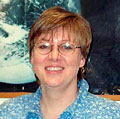 |
|
|
| Author |
Message |
Patty_Cie

Joined: 23 Mar 2004
Posts: 87

|
 Posted:
Wed May 26, 2004 6:47 pm Posted:
Wed May 26, 2004 6:47 pm |
  |
May 24, 2004
4:00 PM Alaska time
Today I followed Sharon Smith (the principal investigator called a PI), Peter Lane, Leopoldo Llinas and Tina Senft from University of Miami while they sampled the East Hanna Shoal 0 station. Sharon’s group is looking at the arctic food chain by studying copepods. Pseudocalanus, a genus of small arctic copepods (about 1 mm), are found on the continental shelf. The copepods graze on the ice algae and in turn become food for the arctic cod. There are also larger arctic copepods from the genus called Calanus. The largest Calanus species are moved from about 1000 m deep in the basin onto the relatively shallow arctic shelves during spring and summer by oceanographic processes that are yet to be fully understood. Because of its size, Calanus has a higher food value to the arctic cod. One of the questions the group is trying to answer is “Do the large-bodied copepods from the basin alter the food chain in the arctic shelves?”
The group deploys two types of sampling equipment to obtain copepods. The first piece of equipment they used today is called a ring net. The vertically towed ring net is used for collecting live specimens. The collected copepods are then used for dry weights and genomic molecular analyses. The ring net is a single net attached to a lead weight and sent down to a pre-determined depth. It is then hydraulically hauled back to the surface; capturing plankton the entire vertical distance.
The second piece of equipment is called a multi-net plankton sampler. The multi-net is a German-made sampling device. It has five separate nets that are capable of sampling at different depths. This is the first time a multi-net has been used in a United States study.
The group uses the multi-net plankton sampler for collecting specimens that are preserved for taxonomic studies. Copepods go through many stages developing from an egg to an adult. Copepods in the juvenile stages are nearly impossible to visually identify by species. The preserved bodies will be taken back to the labs at the University of Miami for DNA recognition. It is hoped that in the future, juvenile copepods will be identified using DNA techniques developed in this study.
In addition to the plankton nets, the group collects surface plankton samples and measures other surface variables such as temperature, salinity and chlorophyll from a pump mounted below deck at the stern. The sampling system operates continuously unless the ice is too thick. With the samples, the group will be able to map surface distributions of juvenile copepods using molecular identification techniques.

Deploying the ring plankton net off the stern. Note - This picture was taken from the helicopter pad two decks above the back work deck.

Ring net coming out of the sea.

The plankton is washed down the net into the collection tubes.

A large bodied Calanus copepod viewed through a microscope. This picture was taken by Peter Lane.

Sharon Smith unpacking the multi-net plankton sampler. Peter Lane and MSTC Don Snider are in the background. Notice for safety everyone is wearing a bright orange mustang suit and a hard hat. A mustang suit is a Coast Guard approved Personal Flotation Device (PFD).

Peter Lane (kneeling) and Leopoldo Llinas prepare the multi-net plankton sampler for deployment.

The multi-net plankton sampler is deployed from the back deck. The steel box above the netting contains sensors. The orange tubes below the netting are where the plankton is collected. The multi-net plankton sampler is so large that the three safety wires normally running along the end of the deck must be removed during its deployment.

Peter Lane is preserving large bodied copepods in ethanol alcohol for future DNA studies.
To see photographs taken by Steve Roberts of UCAR/JOSS, click here. |
|
|
    |
 |
|
|
|
View next topic
View previous topic
You cannot post new topics in this forum
You cannot reply to topics in this forum
You cannot edit your posts in this forum
You cannot delete your posts in this forum
You cannot vote in polls in this forum
You cannot attach files in this forum
You can download files in this forum
|
Powered by phpBB 2.0.11
© 2001, 2002 phpBB Group :: FI Theme ::
All times are GMT
| |
